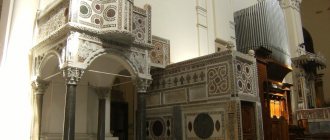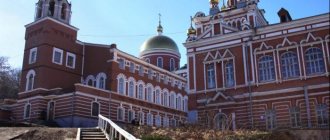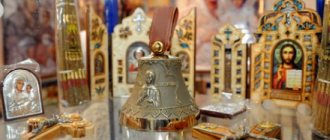What is a chapel and how does it differ from a temple?
A chapel differs from a temple in that it does not have a throne and, accordingly, an altar. This is a place where you can pray and conduct some types of services, except for the main and fundamental one - the Liturgy, for which the throne is necessary.
In other words, what distinguishes a chapel from a temple is not its size, not the number of icons, and not the place where it stands, but only the presence of an altar. If there is an altar, it is a temple; without it, it is a chapel.
The main task and essence of the chapel is to help a person, at a certain moment or in a certain place, break out of the usual bustle and connect thought with God. Therefore, chapels are often found at airports (to pray for a successful flight), in cemeteries (to pray for the departed), in hospitals, at the burial places of saints, and at spiritually or historically significant places.
Once upon a time, rich people organized them in their home or on their territory - to pray in the morning and evening. Sometimes they still do this now.
An example of a chapel that cannot be confused with a temple. The city of Oboyan, Kursk region photo (c) https://www.outdoors.ru/, Ilga Boldareva
Who can build the structure
We found out what a chapel is. Who can build it and what is needed for this?
Any layman (a person who lives in the world) can erect a chapel. To do this, you need to take a blessing from the bishop. And it doesn’t matter whether a “small temple” is being built for a general visit by believers or for oneself personally. Yes, and this exists: the construction of home chapels, where only members of a given family pray.
Who can build a chapel and why not build a temple then?
In fact, anyone can build a chapel - an individual or an organization. It's like buying an icon, only a thousand times larger.
There may be several reasons why the temple was not built:
- understand that they will not be able to consecrate the altar according to all the rules
- understand that they will not be able to guarantee regular services or that they will be inappropriate.
- for this location the temple will be too large a structure.
What does it mean “they will not be able to consecrate the altar according to all the rules”? What are these rules that are so difficult to follow?
The fact is that it is possible to hold a liturgy in a church only when a particle of the relics of some saint is present on the throne - moreover, consecrated by the bishop. That is, just building a temple and consecrating the walls is not enough. This is a thousand-year-old and strict tradition of the Church, which, apparently, has never been violated (there were probably exceptional cases, but they concerned such situations as the liturgy in a concentration camp, when it was conducted with the help of improvised means by a prisoner priest).
It is always possible to organize the consecration of the throne and invite the bishop, but the bishop and the owner of the temple must be sure that this temple will really “live” and not freeze, like an icon hidden in a closet. And this is not a question of rules or regulations, this is a question of responsibility before Eternity, and, well, simply fear of God and respect for traditions.
Having a temple means that there should be at least weekly worship services and people attending them, and it should generally be appropriate. For example, can you imagine a Liturgy with deep confession and communion at a train station or airport?
Entrance to the chapel at Domodedovo airport. As you can see, a chapel can be just a room. As, in fact, the temple.
Or let’s say you are the director of a park, building a chapel, but you understand that inviting a priest and keeping all the expenses associated with active parish life in the park will be too expensive. Or you realize that just a step away from you there is already a church in which liturgical and parish life is already perfectly organized.
It is in such cases that chapels are built.
Chapel of Saints Alexander Nevsky and John the Warrior in Catherine Park, Moscow
Chapels
- Chapel from the village of Gar
- Chapel from the village of Kashira
- Chapel from the village of Malyshevo
Chapels are small religious buildings without altars. They were not intended for permanent or periodic worship. Very often the icons in them were placed on shelves near the eastern wall of the room. Sometimes they were hung on the side walls. Less often, a real iconostasis was set up, albeit with a limited set of icons. But it was also installed close to the eastern wall, sometimes with parts of the side walls turned. In such chapels (with iconostases) on patronal feast days, real divine services were performed, for which a priest was invited from a nearby church.
In the far North, for example, in Karelia and the Arkhangelsk region, chapels looked like small churches with bell towers, often very high. In the Novgorod region (within its current borders) such chapels are not often found.
It is difficult to establish when the first chapels appeared in Rus'. In the 17th century, many of them were already built. It can be assumed that the tradition of building chapels arose much earlier. In the next century, there could be up to a dozen chapels in the parish district. Particularly intensive construction of these small houses of worship began in the 19th and early 20th centuries. The initiators most often were residents of a village or two or three villages, less often clergy. There were many cases when chapels were built as if spontaneously, without pastoral permission and blessing. Why did misunderstandings arise during the consecration of such Chapels? Therefore, the official church fought in every possible way against manifestations of such folk art. But it was not easy to resist him.
Chapels were built in different places, for various reasons and reasons. They could be built in a village, outside the outskirts, on springs (springs), which erupted from the bowels of the earth the purest, very cold, sometimes healing mineral water. Chapels were built in ancient graveyard cemeteries or near large hills.
Later, a modern Orthodox cemetery could grow on the zhalniki, unfortunately, with graves surrounded by high metal fences. Where did this tradition of fencing graves come from? In the second half of the last century - the beginning of ours, fenced burials were a rarity, found only in city cemeteries. Wooden fences began to appear in rural areas only in the last two decades before the Great Patriotic War. Now it has become a tradition, not at all Russian, not Slavic, not good and, I would say, not quite a cultural tradition. Isn't it time to give it up?
One of the examples where “Orthodox” burials completely ruined the ancient Slavic Zhalniki cemetery is a place near the village of Bolshoye Zamoshye, Valdai region. Fresh graves were cut into ancient ones, symbolically surrounded along oval contours by a row of boulder stones. In addition, a road was built on the eastern side, destroying part of the cemetery. Essentially, blasphemy, sacrilege, an outrage against the memory of ancestors and forefathers have been committed. When has this happened before in a Russian village? Where does it come from? There is no chapel in this cemetery, although, according to some information, there was one.
Often chapels were erected according to some kind of vow (promise, obligation) in memory of good luck, misfortune, an unexpected incident, salvation from imminent death, etc. etc. Chapels appeared at crossroads, forks in roads, somewhere on long marches, usually in attractive, beautiful places where one could not only relax, pray, have a snack, but also admire the marvelous surroundings.
There were, and still are, protected, “sacred” groves. They are usually small, stand alone or on the edge of the forest, sometimes near a village. Trees are not cut down here, the land is not plowed, and sometimes a chapel is built. The trunks of centuries-old pines and spruces are decorated with ribbons, towels, fresh flowers and wreaths made from them. You can also find small cast bronze icons, which, unfortunately, are stolen by unscrupulous amateurs. In such places, the most ancient folk (pagan) traditions, the meaning and symbolism of which had been forgotten, were closely intertwined with Orthodox rituals, but already interpreted in their own, homely way.
Chapels were usually made of wood. If they burned out or deteriorated, they were usually renewed, trying to return to the same forms. Brick and stone chapels were built in or near cities. In some areas of the Novgorod region, where there are many boulders or limestone slabs, stone chapels were erected.
In recent decades, these small places of worship have begun to disappear catastrophically, for many reasons. Usually, deprived of supervision, care and repair, they deteriorate and collapse. The chapels in the villages, adapted for various economic needs, were reconstructed, but never repaired. Or this is the case. A very interesting chapel from the 18th century. in the village of Kontsy, Malovishersky district, somewhat dilapidated, damaged by the reconstruction of the 19th century. and later losses, standing in the middle of the village, on the square, the “resourceful” resident dismantled and... built himself a bathhouse from its logs. Know ours! I wonder how the neighbors and all the villagers reacted to this? Previously, for such sacrilege he would have been beaten with sticks and driven out of the village for the rest of his life with a tarnished reputation.
Chapels are robbed, stealing icons and church utensils. There are fewer and fewer of them. This process is difficult to stop, it is almost irreversible. One of the measures to save the chapels was their transportation to the territory of Vitoslavlitsy, to the Novgorod Museum of Folk Wooden Architecture. But the museum’s territory is limited; it is impossible to exhibit a large number of chapels for other reasons. Therefore, only three buildings were transported here.
What are the rules in the chapel and for its creators?
For those who build a chapel, there are essentially two rules (and even then these are not rules in the worldly sense, but self-evident actions).
- consecrate it in honor of some saint. For example, in the Catherine Park in Moscow there is a chapel in honor of Saints Alexander Nevsky and John the Warrior. Prayer services are served there weekly and on the days of remembrance of these saints.
- a cross should be erected on the chapel. We are not talking about the presence of icons inside - this is obvious. Although, how many there should be - there are no rules for this - everything is decided by possibilities.
As for the rest, the chapel can be either from the point of view of architecture or from the point of view of decoration. Another thing is that until recently the architect designing the chapel tried to adhere to the spirit of national traditions. Church buildings are not places for self-expression. Any self-expression or “innovation” in the chapel can ultimately distract the parishioners and the creator of the building from the main purpose. Therefore, they try to make the chapel really, in one way or another, resemble a tiny temple externally, and internally too.
Project of a chapel on Station Square in Barnaul
Some chapels in pre-revolutionary times (and even now) were built according to standard designs. Page from the atlas “Atlas of plans and facades of churches and chapels during buildings in villages” of 1911
Orthodox chapel in Greece. A good example when architecture is completely in tune with the times, but does not destroy the Christian spirit.
It is difficult to talk about rules for parishioners, because they are all dictated either by traditions or by the person’s own attitude to spiritual life. People enter the chapel for one purpose - to pray, to be alone with the spiritual part of themselves. Everything else follows directly from this.
There are no strict rules regarding, say, headscarves for women or shorts for men in the chapel. Although, it would be inappropriate to participate in a prayer service or funeral service in “loose clothing” - for a number of reasons.
How to enter the building
An even stranger question. Of course, with a covered head, if we are talking about a woman. Yes, and there are a few more rules that must be followed when visiting the chapel:
- It is advisable for women to enter while wearing a skirt. Don't forget that this is a small temple. And you can’t wear trousers to church.
- If you want to venerate the icons, make sure there is no lipstick or gloss on your lips.
- During “uncleanness” (critical days), you cannot light candles or venerate icons. You can submit a note on this day, as well as other requests.
- Men enter the chapel without hats.
- Representatives of the stronger sex must wear trousers. Shorts are not allowed.
- It is strictly prohibited to visit the chapel while intoxicated.
- You need to behave properly. You cannot make noise, talk loudly, laugh, or use swear words. Yes, yes, even today’s Orthodox Christians come to this. Today there are cases when visitors to churches and chapels express themselves in indecent words. The question arises about what is the use of visiting a Holy place if a person does not worship God.
What services can be celebrated in the chapel?
Most often, only prayer services are held in chapels (small services for some reason - for example, in honor of a Church holiday or an event significant among the people: war, tragedy, death, or great joy).
Less commonly, there are other types of services for which there is no need for an altar: for example, a memorial service (memory of the dead) or the Hours (a monastic type of small services, during which the reader reads psalms in a certain sequence) - hence the name of the chapel.
The rest of the time, the chapel should, in theory, be open all the time so that anyone can enter. Most often, this is exactly what happens, and they are closed only at night.
Notes
- SES, 1981, p. 1494.
- ↑ 123456
Chapels // Encyclopedic Dictionary of Brockhaus and Efron: in 86 volumes (82 volumes and 4 additional). - St. Petersburg, 1890-1907. - ↑ 1 2
[www.efremova.info/word/chasovnja.html#.VHipBJ_E1j0 Chapel] //
Efremova T. F.
New dictionary of the Russian language. Explanatory and word-formative. - M.: Russian language, 2000
The smallest chapels and chapel pillars
Sometimes chapels are so tiny that you can’t even go into them, but only pray next to them. For example, what kind of chapel stands in the village of Alekseevskoye, Kostroma region. It was built in memory of St. Innocent, the enlightener of Siberia and Alaska:
You don’t see such small chapels very often in Russia, but in Greece, for example, on the contrary, they are very popular: there they are called chapel pillars. They are usually placed along roads, and they are very small. In fact, anyone can build their own chapel










